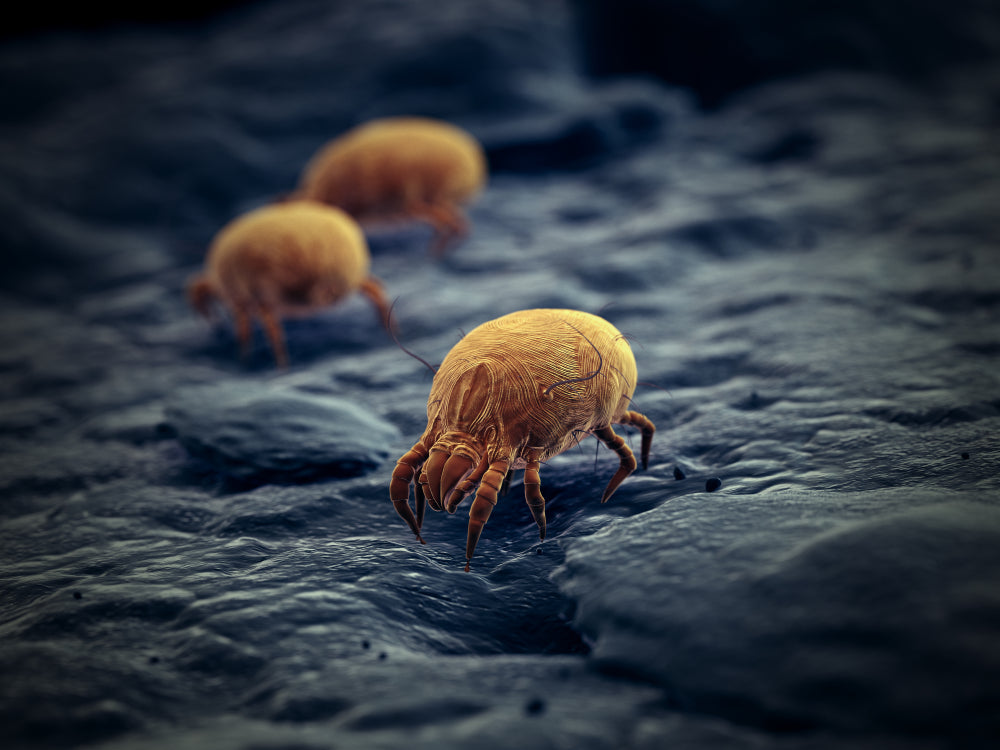Free U.S. Shipping On Orders Over $150

How to Get Rid of Dust Mites From Your Bed
Posted on
Dust mites are one of the biggest sources of allergens in the bed. Your warm and cozy bed provides them with everything they need to survive: a toasty environment, high humidity and an endless supply of dead skin cells (their main chow).
Exposure to dust mite allergens causes a lot of issues for people who are sensitive to them, as well as people with asthma. They affect sleep quality and can have long term health consequences.
Because of how tiny and pervasive they are, tackling dust mites is hard, but not impossible. Below is a guide on how to get rid of dust mites from your bed and bedroom.
What Are Dust Mites and Why Are They Dangerous?
You can’t see them, but if you could you’d see dust mites everywhere around you. Dust mites are tiny insect-like bugs that feed mostly on dead skin cells.
While they can withstand any climate and altitude, dust mites thrive in warm and humid environments, which is why your bed is the perfect habitat for them.
Dust mites are not parasites. They do not bite nor do they feed on our blood. In fact, the bugs themselves are pretty harmless. The problem is their waste products.
Breathing in proteins present in the urine, feces and decaying bodies of dust mites can cause your immune system to go into overdrive, causing allergy symptoms. They can also trigger asthma attacks.
Dust mite allergy can range from mild (occasional symptoms like a runny nose and sneezing) to severe (persistent and life-disrupting symptoms like coughing, congestion and breathlessness). Dust mites can also make your skin itchy.
Dust mites are particularly dangerous to people with asthma. Frequent exposure to dust mites can worsen the condition and cause life-threatening attacks. Some researchers also think long term exposure to dust mites can cause asthma in otherwise healthy patients.
Dust mites can also cause inflammation on the skin, which can trigger an acne breakout.
How to Get Rid of Dust Mites from Your Bed
1. Control Humidity in Your Bedroom
Humidity is the main factor determining the level of dust mites in an environment. Dust mites don't drink water. Rather, they suck moisture out of the air. So controlling humidity levels in your bedroom will massively reduce your exposure to dust mites.
Dust mites thrive in high humidity environments between 70% and 80%. Keeping your bedroom at 30-50% humidity will significantly reduce dust mite allergens. Coincidentally, that’s about the perfect humidity range for good sleep.
The easiest way to manage humidity is using a dehumidifier. Look for one with a built-in humidistat, meaning it can automatically sense and adjust humidity in the bedroom.
Turning on the AC also reduces humidity, though this uses a lot of power if you want to keep humidity low all the time. Turning on a fan, opening a window or installing a ventilation fan are other ways to manage humidity.
In addition, check that there’s nothing that’s adding humidity in your bedroom such as a plumbing leak, or indoor house plants.
2. Wash Bedding Once or Twice a Week
Washing bed linen in hot water (140F/60C) kills dust mites and gets rid of dust mite allergens. But if you have delicate bedding that can’t take the heat, experts say you can wash at a lower temperature (86-104F) and then run it through two rinse cycles.
Putting bedding in the dryer for 15 minutes at a minimum temperature of 130F is also effective at killing dust mites.
Note: Sun drying, which is great for freshening and sterilizing bedding, also kills dust mites. However, it does not get rid of dust mite allergens.
To make sure dust mites don’t build up to unhealthy levels in your bed, wash your bedding at least once or twice a week. If you have asthma or severe allergies, consider changing out bed linen up to 3 times a week.
3. Use a Mattress Protector
Mattresses gain a few pounds over their lifetime as they become host to an ever increasing colony of dust mites. These dust mites can cause serious health problems for allergy and asthma sufferers.
What makes it worse is that a mattress is not as easy to clean as bed sheets or pillowcases. Even vacuuming a mattress may not completely get rid of dust mites that have burrowed deep inside the foam. Which is why the best solution is to keep dust mites from getting on the mattress in the first place.
A waterproof mattress protector keeps dust mites and other allergens like mold and dander from settling on the mattress. It also keeps the mattress dry, making it a less friendly environment for pet dander.
Wash your mattress protector at least once a month to keep dust mite levels under control.
4. Dust and Clean Your Bedroom Regularly
Most dust mites live in house dust. So the dustier your bedroom is, the more dust mites you are likely to have.
Cleaning and dusting your bedroom often can help keep dust mite levels low. Get rid of clutter as it provides the perfect place for dust mites to thrive.
5. Reduce Soft Furnishings
Soft surfaces like carpets and rugs are perfect habitats for dust mites, as well as other allergens like pollen and pet dander.
Eliminating soft furnishings from your bedroom will help you breathe and sleep easier. Wall to wall carpets are the worst, though area rugs can host lots of bad stuff, too. Upholstered furniture like a couch and soft decorations such as plush toys can also be an allergy hazard.
If you have to keep a carpet in your bedroom, look for a low-pile one and vacuum it daily. As for area rugs, get washable ones that you can throw in the washing machine.
Quick links
Contact
6063 Hudson Road #160
Woodbury, MN 55125
Yo@hercLeon.com
Leave a comment: